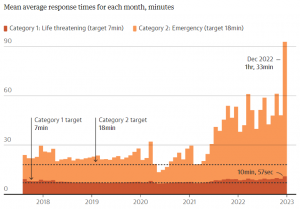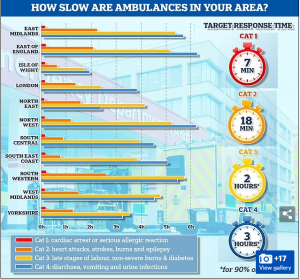Ambulance response times worst on record
Emergency patients across the UK are having to wait for the longest time in history for an ambulance.
Patients with heart conditions and strokes on average are having to wait over an hour and a half before receiving help, when the response time for category two should be 18 minutes.
Last month, more than half of patients at major A&Es had to wait longer than four hours, a first since records began in 2011. As a result, average ambulance response times in England have become the longest on record.
How long should an ambulance take to respond?
The average time for Category one target time is 7 minutes and is now at 10 min 57 sec and for Category two it was 18 minutes and as of December 2022 it was at 1 hour 33 minutes.
How slow are ambulances in your area?
With ambulance times being at a high, there are certain areas in the UK that are more affected than others. In the UK, for Category one and two, the South West has the slowest response time, than any other area.
If you want to see the response time in your area, try the interactive tool: https://bit.ly/3RcUZ6r
But why is the wait time getting worse?
Although the staff has grown, capacity has decreased as a result of ambulances waiting with patients outside hospitals for longer periods of time.
More than one in ten ambulances waited over an hour in July 2022. When wait times exceeded the 15-minute threshold in July 2022, ambulance capacity decreased by roughly 20%.
Small increases in handover times can result in much larger increases in average response times because the system is overloaded. A significant factor in the decline in ambulance performance is the increase in handover delays.
NHS struggling
In December A&E’s were overwhelmed, with nearly 1,800 patients having to wait at least 12 hours to be seen. Only 66% of patients were seen in the 4 hours.
However, the Health chiefs claim that because of the winter pressures, the lack of beds has had a knock-on effect on paramedic’s response time. The nurse strikes and ambulance strikes in December also has an impact on December response time.
The figures for January 8th, are suggesting that the pressure is easing up:
⦁ 28% decrease in ambulance queues
⦁ 3% decrease in medics being off sick
⦁ 11% decrease in people with Covid taking a bed
⦁ 4% decrease in flu patients in hospital beds


